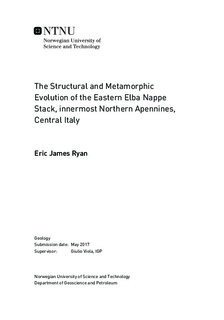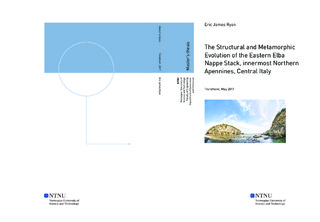| dc.description.abstract | This thesis provides a new model for the structural and metamorphic evolution of the Eastern Elba Nappe Stack (EENS), in the innermost Northern Apennines, Central Italy, based on detailed field mapping and macro and microstructural analysis by Electron Backscatter Diffraction (EBSD), Energy-dispersive X-Ray Spectroscopy (EDS), and the calculation of phase equilibria.
The complex tectonic evolution of the orogenic wedge can be conceptualized by a sequence of distinct deformation episodes, referred to sequentially as D1 through D6. Although each event is distinct from the others, the dynamic nature of wedges is such that different episodes might be transiently active coevally at different structural levels of the wedge, even mutually overprinting as deeper portions of the system are progressively exhumed toward the surface and shallower domains. This results in complex geometric and overprinting relationships, which can make it difficult to read and unravel the details of these structural evolutions.
D1 represents an initial phase of underplating in the Eocene Oligocene. It led to a thick accretionary wedge and the development of only recently documented HP-LT blueschist facies metamorphism, scantily preserved on Elba Island. This initial phase was followed by prolonged exhumation during the Late Oligocene Early Miocene during D2. For the first time, the prolific west-vergent D2 structures of the EENS are documented and incorporated into a model, explaining the exhumation of the HP-LT assemblage through westward extension as part of a channel flow process during retrograde greenschist facies metamorphism.
Exhumation was followed by a renewed phase of compression, D3, from the Early to Middle Miocene, during which eastward out-of-sequence thrusts and pervasive east-vergent isoclinal folding deformed the EENS. The east-vergent folds have been documented at all sizes, ranging from the micro- to kilometric scale, including the previously undescribed Acquadolce Antiform, a kilometric-scale fold in the southern portion of the Acquadolce Unit.
Gravitational instability led to eastward extension in the Middle Miocene during D4. After which, a final compressional D5 stage, characterized by compression lasting from the Late Miocene to the Pliocene occured. The Monte Capanne (8 Ma) and Porto Azzurro (5.9 - 6.2 Ma) plutons were emplaced during this phase, and syn-contact metamorphic structures developed. Major D5 structures include a HT-LP mylonitic belt with east-vergent thrust kinematics causing the juxtaposition of low-grade or non-metamorphic rocks onto the higher-grade Acquadolce Unit along the Capo Norsi Thrust. This was followed during D5b by the formation of the world-famous top-to-the-east, low-angle Zuccale Fault (ZF), which until recently has been interpreted as a normal fault. Recent publications and this study indicate that the ZF is actually a thrust, formed during the final phase of compression.
Finally, during a D6 phase of Late Pliocene Pleistocene age, uplift and brittle normal faulting affected the EENS, through the formation of new faults and the reactivation of earlier thrust structures.
The structural and metamorphic evolution of the EENS and innermost Northern Apennines, though complex, reflects the relatively simple processes controlling dynamic and cyclic wedge growth. | |

